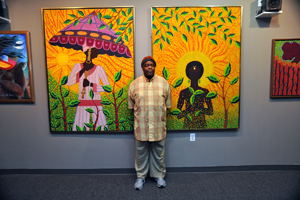US | A Weusi Reunion at Harlem’s Dwyer Cultural Center
 Weusi Artist Gaylord Hassan stands in front of his artwork at the Dwyer Cultural Center
Weusi Artist Gaylord Hassan stands in front of his artwork at the Dwyer Cultural Center
By Grace Aneiza Ali
Originally published on February 19, 2010 for The Defenders Online, a publication of the NAACP LDF
“The last time we all got together like this was in 1975,” says Taiwo Duvall as he stands in one of the gallery spaces at the Dwyer Cultural Center. It’s a frigid Tuesday evening in Harlem. It’s been snowing and sleeting for most of the day. Despite the precarious weather, over 200 people have packed the Dwyer, in what looks and feels more like a family reunion than the Center’s opening for the exhibition, Weusi Revisited: 2010.
Duvall is standing with his daughter and his son-in-law. Mounted on the wall behind them are several of his multi-colored woodblock prints. “Art,” says his daughter proudly, “is definitely a family affair.” Sharing the gallery walls with Duvall are the works of sixteen other Weusi artists. They are the reason for the reunion.
In 1965, against the backdrop of the Civil Rights and Black Arts Movements, a group of artists established themselves in Harlem as the Weusi Artist Collective. As distinct and unique as their individual works were, the common thread among them was an aesthetic and political agenda to make African imagery a central part of the art they created. In the midst of the “Black is Beautiful” and “Black Power” slogans of the time, these artists returned to African roots, choosing to name themselves Weusi, the Swahili word for blackness.
Duvall has a simple answer to the question of why the Weusi was formed at the height of these two powerful socio-political movements. “Because it didn’t exist,” he says. His words echo a similar sentiment expressed by Toni Morrison on why she wrote the Pulitzer-prize winning novel The Bluest Eyein 1970. “There were no books about me. I didn’t exist in all the literature I had read.”
It’s a story of void and absence that many of the Weusi artists know too well. Long-time Harlem resident Robert Daniels, who was joined at the Dwyer that night by his two daughters and his young grandson, recounts his formal training in Western European painting. “There were times that I would try to draw black people. They had black faces, but they didn’t look like us.” When he began painting in the mid-1970s, he turned to photographing people on the streets of Harlem. He used them as study guides on capturing the anatomy and facial compositions of black people. “When I began to draw us,” he says, “I began to understand the depths of myself.”
The Dwyer used the opening reception to premiere the exhibit’s companion film, Weusi Revisited: 2010. For most of the Weusi artists, it was their first time seeing it. The personal narratives and background stories, like those of Daniels, are what David Lackey, the film’s producer, find just as compelling as the Weusi artwork itself. “Usually, the work of art hangs silently on the wall. For the Weusi, I felt that it was important to convey the artists’ voice and personality associated with the painted images,” says Lackey.
The film, which the Dwyer will screen for the public throughout the year, interweaves the artists’ words with a visual choreography of their work. Their collective voices serve as a soundtrack for an historically fertile and often turbulent period in our nation’s artistic, cultural and political landscape. “We were warriors. We are warriors,” Ademola Olugebefola says in the film, as he recounts his roots with the Weusi. “We set out to beautify the black woman, regalize the black men in our images, promote the culture, the beauty and brilliance of color within the African tradition.” For the men and women of the Weusi, art and activism were one and the same.
The evening’s celebration of the Weusi served as the launch pad for the Dwyer’s ambitious year-long celebration of the Black Arts Movement in Harlem. As the first cultural center in New York City devoted to celebrating Harlem’s history and artistic traditions, the Center plans to host a cadre of public symposiums, gallery talks and artist workshops with Weusi members, and documentary screenings that delve into Harlem’s role in the Black Arts Movement.
Only in its seventh month since opening last Summer, the Dwyer is positioning itself as an institution committed to the simultaneous task of showcasing what Harlem currently has to offer as well as honoring its past. “Many of these artists are often forgotten,” says Voza Rivers, co-director of the Dwyer. “They’ve had their own personal stories of struggle and hardship. We want to make sure that our community recognizes what they’ve done.”
It’s a message that seemed to resonate with the guests as they poured out of the Dwyer’s screening room, having just seen the Weusi film. Jason Auguste, who is the Creative Director at the Harlem Chamber of Commerce and an artist himself, says it was personally important for him to be there. “The Weusi for me is a connection between the past and the future. Although the artists may have aged, their art doesn’t. It’s still very relevant today.”
Weusi Revisted: 2010 runs through September 3 at the Dwyer Cultural Center [dwyerccc.org] in Harlem, New York City. Both the exhibit and the film feature the artists Abdullah Aziz, Ché Baraka, David Byer-Tyre, Kay Brown, Perry Cannon, Stanwyck Cromwell, Robert Daniels, Ogundipe Fayomi, Gaylord Hassan, M L J Johnson, Niiahene La Mettle-Nundoo, Dindga McCannon, Otto Neals, Ademola Olugebefola, Okoe Pyatt, Taiwo Duvall and Emmett Wigglesworth.
Originally published on February 19, 2010 for The Defenders Online, a publication of the NAACP LDF.
